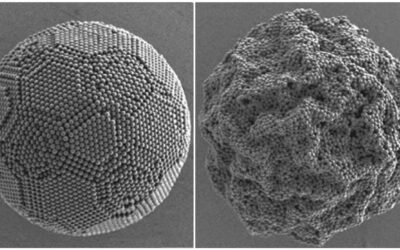Plasmonics open new ways of controlling the flow of light both at the micro- and nanometer scales through the enhanced interaction of photons with clouds of free electrons in metals. Nanostructured metals that support such coupled oscillations have long been known as efficient nanometer-scale antennas capable of “catching” light in the visible region of the electromagnetic spectrum. Using this unique phenomena, the field of plasmonics promises breakthrough advances in several areas such as single molecule sensing, subwavelength waveguiding, imaging with the nanometer resolution, denser data storage, medical therapies, and novel concepts for energy harvesting.
With the rapid advances in the field of plasmonics, there has been an endeavor to identify new plasmonic materials that can provide unique properties; such as high temperature durability, chemical inertness, process compatibility, tunability, and low optical losses, to solve application-specific challenges. Transition metal nitrides support plasmonic oscillations in the visible and infrared ranges of the electromagnetic spectrum (including the important telecommunication spectral window) and are refractory – that is to say, they retain their strength and properties at high temperatures. The unique combination of these properties enables the use of plasmonic metal nitrides in applications that impose harsh environmental conditions. Among other plasmonic transition metal nitrides, titanium nitride is a material of choice in several industries including protective coatings, bio-medical, and microelectronics.

a) Top view SEM images of TiN nanowires after nitridation. b) Schematic illustration of the experimental setup showing the optical measurement with θ indicating the incident angle of s-polarized light.
Researchers from Purdue University demonstrated a new approach to fabricate large-scale, complex nano-architectures of refractory plasmonic transition metal nitrides via nitridation of oxides. They started with titanium dioxide, an abundant material with well-known material synthesis and wide use as a pigment, and obtained titanium nitride with plasmonic properties in the visible range. While the replacement of oxygen atoms with nitrogen in an ammonia environment at high temperatures was known earlier, this study shows that the resulting material demonstrates a clear transformation from dielectric to metallic properties with plasmonic resonances and typical characteristics of single-crystalline titanium nitride nanoparticles.
These findings can trigger a new research direction focusing on complex refractory plasmonic designs via oxide synthesis and open the path to the low-cost fabrication of large-scale, complex nano-architectures of refractory plasmonic materials for lightweight, high performance optical devices capable of withstanding extreme environmental conditions. 3D nano-architectures based on refractory plasmonic transition metal nitrides can be realized for metamaterial applications that require higher temperatures than what plasmonic metals could withstand. Spectrally and angularly selective surfaces for engineered absorption and emission of light, energy harvesting, and sensing are some examples among many areas of potential use. The technique also combines titanium nitride, an efficient plasmonic absorber over the entire solar spectrum, with titanium dioxide, a widely-used photocatalyst, and provides an interesting avenue for plasmon-enhanced photocatalysis research.
The article is highlighted on the back cover of issue 7 in Advanced Optical Materials.

















